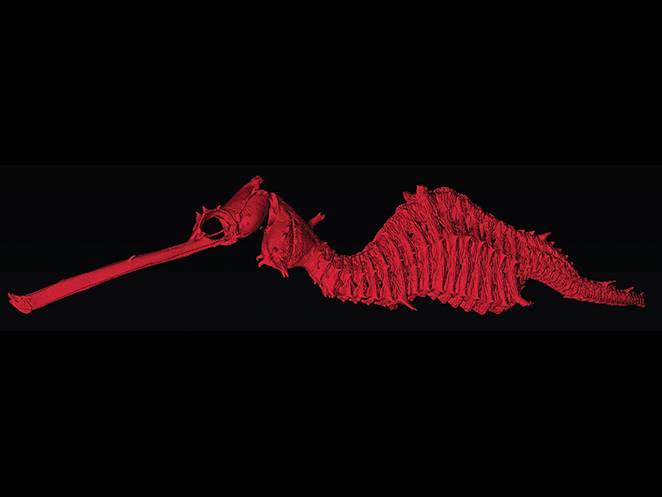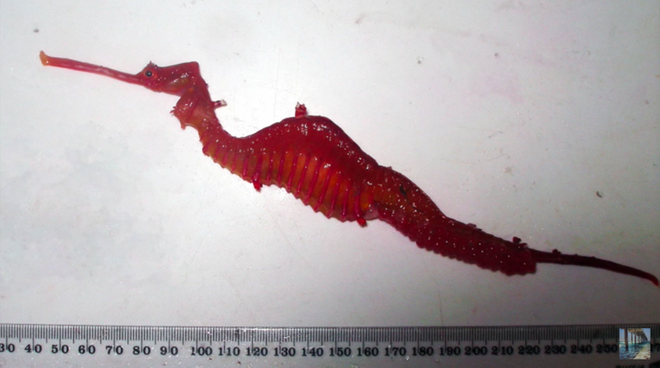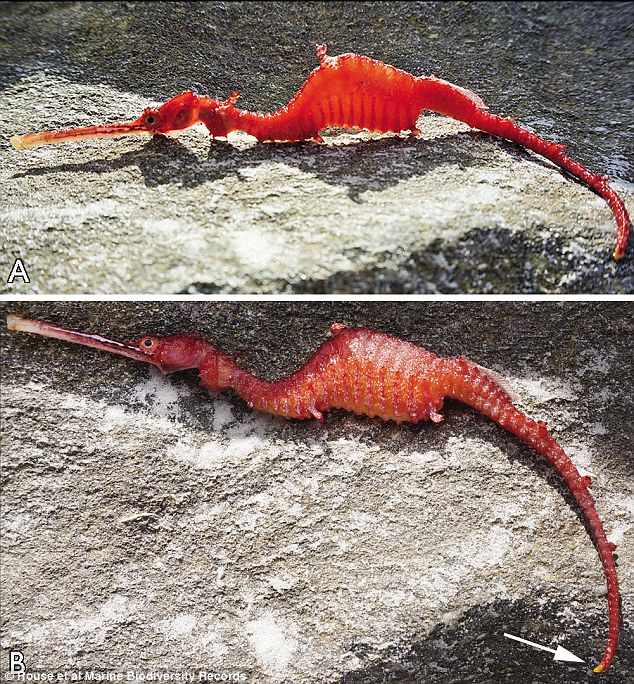A group of Australian biologists had the opportunity to watch for the first time alive the recently discovered seadragon that they called the “ruby seadragon.”
The existence of this animal is known since 2015, but the footage the biologists gathered is the first record of the seadragon ever. Researchers at Scripps Institution of Oceanography at the University of California San Diego and the Western Australian Museum conducted an investigation in the Western coast of Australia to explore and see if they could watch the seadragon in its habitat.

For days the research team searched the waters with a small and remotely operated vehicle (miniROV). This device was located over 164 feet deep (or 50 meters). During that time, the scientific group could localize two ruby seadragon within a time lapse of 30 minutes, achieving the first recording of the species since its discovery in 2015. They managed to see the seadragon in sea areas near Western Australia’s Recherche Archipelago.
The scientists determined the existence of this seadragon when analyzing dead specimens of the animal. Before the discovery, there was only two types of seadragons: the common seadragon and the leafy seadragons. However, through further investigations, the scientific community defined that the ruby seadragon was incorrectly classified as a common seadragon.
Marine biologists from the Scripps Oceanography Josefin Stiller and Greg Rouse along with Western Australian Museum investigator Nerida Wilson, explained last year that the ruby seadragon was a misidentification on the specimen and that further investigations must be done to understand its real type.
With the use of computer tomography technology, the scientists were able to create a 3-D model of the new seadragon and realize that the new type was different to the other two known species.
“Until last year, no one had ever suspected a third species of seadragon existed,” said Rouse, lead author of the study and curator of the Scripps Benthic Invertebrate Collection. “This discovery was made thanks to the great benefit of museum collections.”
Differences between known seadragons and the discovered one
The recording achieved by the investigation team allowed the confirmation of the characteristics that makes this ruby seadragon different when comparing it to other specimens. This particular type does not have leaf-like appendages, which is a feature that is common in all formerly known species of seadragons.
The seadragons use leaf-like appendages to camouflage in lush seaweed and kelp meadows, areas where these animals often live.

“It was really quite an amazing moment,” said Scripps graduate student Stiller, a coauthor of the new study published in the Jan. 13 issue of the journal Marine Biodiversity Records. “It never occurred to me that a seadragon could lack appendages because they are characterized by their beautiful camouflage leaves.”
This was not the only discovery that the research team found when observing the animal. They also saw that the ruby seadragon has a “prehensile tail,” that is similar to tails that other sea species have like seahorses and pipefish. This kind of tail is not present in any of the other known specimens of seadragons.
According to recent investigations, scientists believe that the ruby seadragons use this tail as a tool for grabbing particular objects in the bottom of the sea, specifically in high-surge waters, the areas that the team explored.
One of the only things that the investigators found in common with the other known species is at the moment of feeding, as all seadragons (including the newly discovered one) strike at the prey in the same way.
The researchers were able to confirm the reddish coloration of the fish along with its habitat. The places where the ruby seadragon lives do not have kelp or seagrass as they are full of sponges. It was thought that it was an inconvenient habitat for seadragons until the discovery.
The investigation team believes that the ruby seadragon lost its leaf-like appendages due to a different evolution that the one presented in the other types of seadragons. They also think that the ruby coloring of its skin is a camouflage method, considering that it lives in sea deep waters.
To define if the ruby seadragon “curled” its tail due to a legacy from its pipefish ancestors or if the other types of seadragon lost it trough an evolution process, more studies must be conducted.
Ruby seadragon protection
In the conclusions of the study, the investigation team explained the danger that this species is currently facing. The researchers are worried about a possible overfishing of the animal now that it has become an official discovery.
According to the investigation, the evidence suggests that the ruby seadragon has small populations in the Western Australian coasts, although there is not enough evidence to sustain that affirmation.

Source: Biomedcentral

That a friggin red seahorse